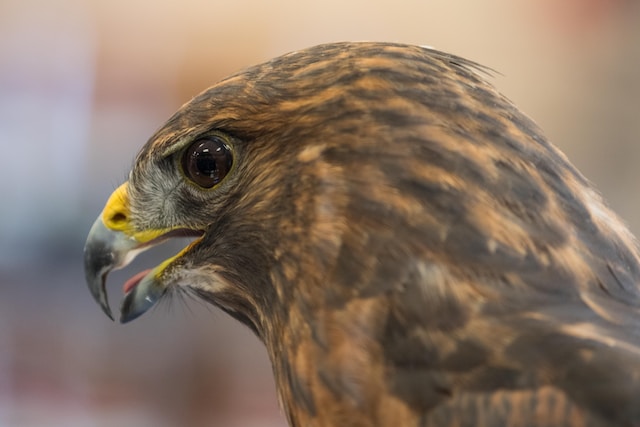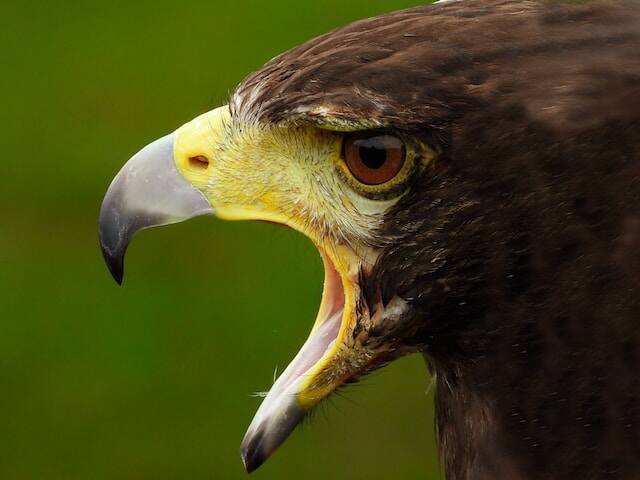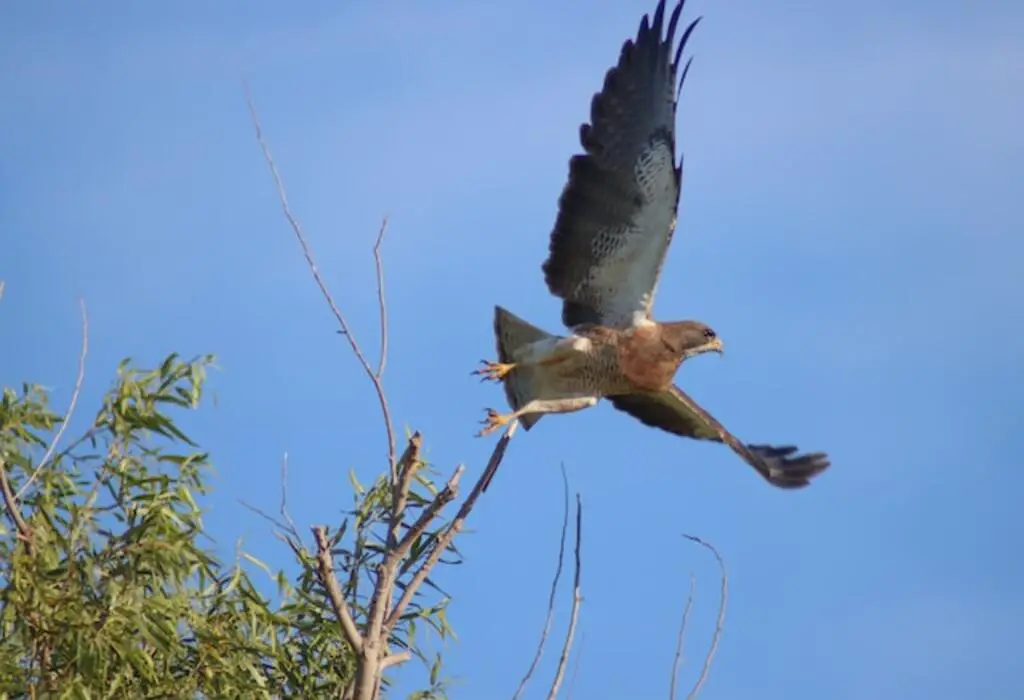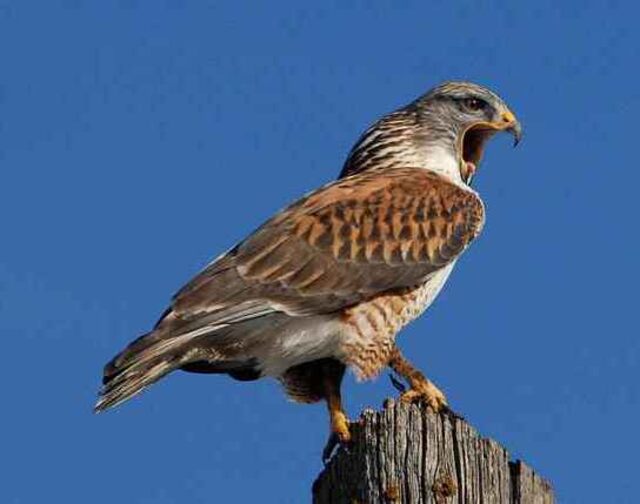In the vast skies above, hawks glide gracefully, their sharp eyes scanning the terrain below for prey. These majestic birds of prey are often associated with power and freedom, and their distinctive calls add to their mystique.
However, not many people are aware of the variety of sounds that hawks make, including chirping.
Hawks are known for their piercing screeches, but their vocalizations are far more complex than that. In fact, hawks are capable of producing a range of sounds, from soft chirps to aggressive screams.
While many people may assume that hawks only screech, the reality is that they have a sophisticated vocal system that they use for communication and survival.
In this article, we will explore the question: do hawks chirp?
We will delve into the reasons behind their vocalizations, the differences between chirping and screeching, and the importance of these sounds in the biology of hawks.
Table of Contents
- 1 Key Takeaways
- 2 Do Hawks Chirp?
- 3 Overview of Hawk Vocalizations
- 4 Hawk Chirping
- 5 Reasons for Chirping
- 6 Differences between Chirping and Screeching
- 7 The Importance of Vocalizations in Hawk Biology
- 8 Research and Studies on Hawk Vocalizations
- 9 Other Fascinating Facts about Hawks
- 10 Conservation Efforts for Hawks
- 11 Conclusion and Future Directions for Hawk Vocalization Research
- 12 Frequently Asked Questions
- 13 Author
Key Takeaways
- Hawks have a sophisticated vocal system with a range of sounds from soft chirps to aggressive screams, which serve various functions including communication, territorial defense, and courtship displays.
- Chirping is important for social and reproductive lives of hawks and used in non-threatening situations, while screeching is a sign of aggression.
- Hawks use a combination of vocalization patterns and body language to convey messages, and their vocalizations play a crucial role in parent-offspring communication during feeding and nest guarding.
- Conservation efforts are crucial to protect hawks from threats such as habitat loss, pesticide exposure, and illegal hunting, and research on hawk vocalizations sheds light on their behavior, ecology, and evolution.

Do Hawks Chirp?
Yes, hawks do not chirp like some smaller songbirds. Instead, they produce a variety of vocalizations, including high-pitched screams, screeches, and keening calls.
These vocalizations serve purposes such as territorial defense, communication with their mates, and vocal displays during courtship.
Overview of Hawk Vocalizations
Hawk vocalizations are diverse and complex, ranging from high-pitched screeches to low-pitched whistles, and serve a variety of functions such as communication, territorial defense, and courtship displays.
Hawks use a combination of different vocalization patterns to convey different messages, depending on the situation.
For example, a high-pitched screech may be used to warn off intruders, while a low-pitched whistle may be used to attract a mate.
Hawk communication is not limited to audible sounds, as they also use body language to convey messages such as aggressive postures or courtship displays.
While hawks are known for their piercing screeches, they also produce softer chirping sounds, which may be used for communication as well.
Understanding the complexities of hawk vocalizations can provide insights into their behavior and social interactions, including the elusive question of whether hawks chirp.
Hawk Chirping
Despite their reputation as fierce predators, some avian species possess unexpected vocal abilities that may surprise observers.
Hawks, for instance, are known for their piercing screeches and ear-piercing screams that can be heard from a distance.
However, these birds also possess chirping behavior that is less commonly observed.
Hawk communication is complex, and chirping is just one of the ways that they communicate with each other.
This vocalization is often used by hawks to communicate with other hawks during mating season or to signal the presence of prey.
Although the chirping behavior of hawks is less common than their screeches and screams, it is still an important part of their communication system.
In the next section, we will explore the reasons why hawks chirp and what this behavior can tell us about their lives.

Reasons for Chirping
The vocal communication of avian species is often more complex than what is commonly assumed, with hawks possessing a surprising ability to produce chirping sounds. These chirping sounds are not only unique to each species but also serve different causes and functions.
Here are the three possible causes and functions of hawk chirping:
1) To communicate with their mate during courtship,
2) To establish territory boundaries and warn off intruders, and
3) To communicate with their young ones.
Hawk chirping, therefore, serves an important role in the social and reproductive lives of these birds. In the next section, we will explore the differences between chirping and screeching, which are both vocalizations commonly associated with hawks.
Differences between Chirping and Screeching
A comparison of chirping and screeching in avian vocalizations reveals distinct differences in frequency, pitch, and duration. Chirping is characterized by a high-pitched, rapid sound with a short duration, while screeching is a long, piercing, and low-frequency sound.
Hawks, like other birds, use vocalizations to communicate with each other for various reasons, including mating, territorial disputes, and warning signals.
Chirping is often used in non-threatening situations, such as during courtship, while screeching is a sign of aggression and is used to defend territories or warn others of potential danger.
Understanding the differences between chirping and screeching in hawk communication is important for researchers to better understand the birds’ social behavior and ecology.
The vocalizations of hawks and other birds play a crucial role in their survival and reproduction, and further research on this topic can provide valuable insights into the biology of these fascinating animals.
The Importance of Vocalizations in Hawk Biology
Vocalizations are akin to a language that hawks use to convey important messages such as mating, territorial conflicts, and warning signals.
The importance of vocalizations in hawk biology cannot be overstated as it plays a significant role in their survival.
Hawks use a variety of vocalizations such as chirps, screeches, whistles, and screams to communicate with each other.
These sounds are produced by the syrinx, a vocal organ located at the base of the trachea.
Hawks use these sounds to communicate with their mates during courtship, to defend their territories, and to warn others of potential danger.
For instance, hawks will emit a high-pitched scream to warn other birds of prey in the area.
Vocalizations also play a crucial role in parent-offspring communication during feeding and nest guarding.
The table below shows some of the different hawk vocalizations and their meanings. Understanding hawk vocalizations is critical for bird watchers, ornithologists, and researchers who study these birds.
The table highlights the complexities of hawk vocalizations and their importance in communication.
| Vocalization | Meaning | Context |
|---|---|---|
| Chirp | Mating call | Courtship |
| Screech | Warning signal | Danger |
| Whistle | Territorial call | Defense |
| Scream | Alarm call | Danger |
| Trill | Aggression | Territory disputes |
Research and studies on hawk vocalizations have shown that these birds have a remarkable ability to communicate with each other over long distances.
Scientists have used acoustic monitoring to study the vocalizations of hawks and their behavior.
These studies have revealed fascinating insights into the intricate world of hawk vocalizations and their importance in communication.
More research is needed to understand the complexities of hawk vocalizations and how they contribute to their survival in the wild.
Research and Studies on Hawk Vocalizations
Studies on the acoustic properties of hawk vocalizations have revealed the intricate and complex nature of their communication system, shedding light on their survival strategies in the wild.
Hawks use a variety of vocalization patterns to communicate with other hawks, such as alarm calls, territorial calls, and courtship calls.
These vocalizations not only convey information about the hawk’s location and intentions but also play a crucial role in establishing and maintaining social hierarchies within hawk communities.
Research has shown that hawks can even recognize individual voices, indicating a level of social complexity that was previously unknown.
By understanding the intricacies of hawk communication, researchers hope to gain insights into their behavior, ecology, and evolution.
Other fascinating facts about hawks include their incredible eyesight, agile flight, and diverse hunting strategies.
Other Fascinating Facts about Hawks
Hawks possess remarkable physical abilities, including acute vision, powerful talons, and the ability to fly at high speeds and maneuver with precision.
These abilities make them highly successful predators, as they are able to spot prey from great distances and swoop down to capture it with their talons.
Hawks are also known for their impressive migration patterns, with some species traveling thousands of miles each year.
Despite their impressive abilities, hawks face numerous threats, including habitat loss, pesticide exposure, and illegal hunting.
Conservation efforts are crucial in protecting these magnificent birds and ensuring their survival for future generations.
Conservation Efforts for Hawks
Despite the potential economic benefits of hunting hawks, it is important to prioritize conservation efforts in order to protect these birds and maintain ecological balance.
The hawk population has been declining due to habitat loss, hunting, and the use of pesticides.
Habitat preservation is essential to the survival of hawks, as they require large areas of undisturbed forest to nest and hunt.
Conservation efforts include creating protected areas, enforcing hunting regulations, and reducing the use of harmful pesticides.
These efforts not only benefit hawks, but also contribute to the preservation of other species that share their habitat.
It is crucial to continue these conservation efforts to ensure the survival of hawks and maintain a healthy ecosystem.
The study of hawk vocalization is also important for understanding their behavior and communication patterns.
The next section will discuss the current state of research on hawk vocalization and future directions for this field.
Conclusion and Future Directions for Hawk Vocalization Research
Future research on hawk vocalization holds potential for enhancing our understanding of their behavior and communication patterns, contributing to the conservation efforts of these important birds of prey.
As technology advances, researchers can use various tools to study vocalizations, such as acoustic monitoring and bioacoustics.
By analyzing the frequency, duration, and context of hawk calls, scientists can better understand how these birds communicate with each other.
This information can then be used to identify and protect their habitats, as well as evaluate the effectiveness of conservation efforts.
Furthermore, studying hawk vocalizations can provide insights into their social structures and breeding behavior, which can aid in captive breeding programs and the reintroduction of endangered species into the wild.
Overall, the implications for conservation are significant, and future research on hawk vocalization can contribute to the protection and preservation of these magnificent birds.
Frequently Asked Questions
What is the average lifespan of a hawk?
The average lifespan of a hawk varies depending on the species, with some living up to 30 years. Breeding habits and migration patterns also impact their longevity. Hawks are known for their freedom of movement and impressive hunting skills.
How do hawks hunt for prey?
Hawks use various techniques to hunt prey, including soaring, perching, and diving. Their prey preferences vary depending on their species and habitat. They typically target small mammals, birds, reptiles, and insects.
What is the difference between a hawk and an eagle?
Hawk vs Eagle: a comparison of characteristics and behaviors reveals differences in hunting techniques. Eagles are larger and more powerful, with a preference for fish, while hawks are smaller and more agile, preying on smaller animals. Both exhibit a keen sense of vision and hunting prowess.
What are the most common types of hawks found in North America?
North America is home to various hawk species, including Red-tailed, Cooper’s, and Sharp-shinned hawks. Captive breeding programs and conservation strategies aim to protect these birds, ensuring their survival and freedom in the wild.
What is the habitat range of hawks?
Hawks have a diverse habitat range, with some species residing in forests, grasslands, and deserts. Migration patterns vary among species, with some migrating long distances. Nesting habits also vary, with some hawks nesting in trees and others on cliffs or the ground.





